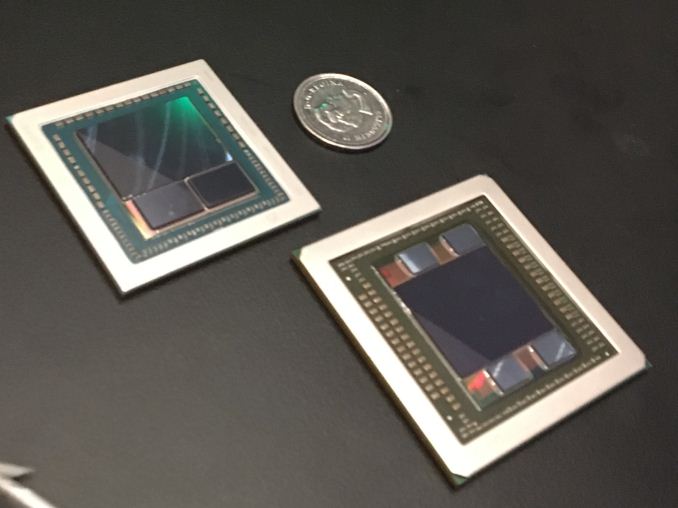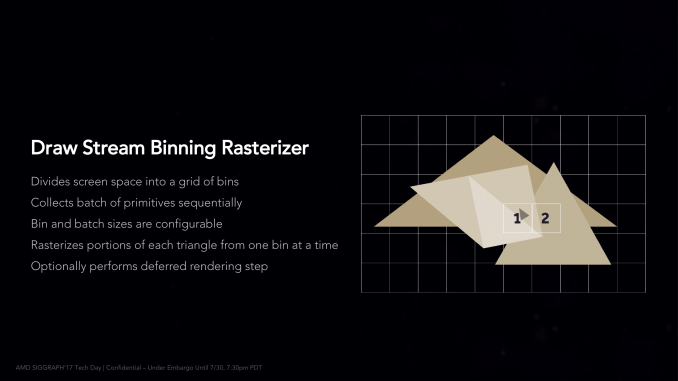Radeon RX Vega Unveiled: AMD Announces $499 RX Vega 64 & $399 RX Vega 56, Launching August 14th
by Ryan Smith on July 30, 2017 10:30 PM ESTFeatures & the Future Launch
Last but not least, along with today’s card announcements, AMD has also lifted the embargos on the architectural elements of the Vega 10 GPU. While there are no new architecture features to discuss – it turns out AMD was rather thorough with their preview at the start of this year – there’s still quite a bit in the way of details to dig into here. In fact it's more than I can hope to cover in a single day, let alone the few hours I’m getting to write this article ahead of AMD’s embargo. So I want to hit the highlights.
First and foremost, AMD has clarified that they do not consider Vega 10 to be a high performance computing (HPC) chip, unlike Hawaii. In particular, Vega 10’s native FP64 rate is just 1/16, like AMD’s other consumer chips. And the chip, while supporting HBM2’s native ECC mode, doesn’t have ECC on its internal pathways. This doesn’t mean that the chip can’t be placed in a server – its FP16 and INT16/INT8 performance is the cornerstone of its existence as part of the Radeon Instinct family. But that’s still a different market than traditional HPC. When we might see another HPC chip from AMD is anyone’s guess at this moment.
Second of all, we have a formal die size and transistor count for Vega 10. The GPU is officially 486mm2, containing 12.5B transistors therein. That amounts to 3.9B more transistors than Fiji – an especially apt comparison since Fiji is also a 64 CU/64 ROP card – all the while being 112mm2 smaller than Fiji (despite the higher transistor count) thanks to the higher density of GloFo’s 14nm LPP process, which AMD is using to fab the chip.
Talking to AMD’s engineers, what especially surprised me is where the bulk of those transistors went; the single largest consumer of the additional 3.9B transistors was spent on designing the chip to clock much higher than Fiji. Vega 10 can reach 1.7GHz, whereas Fiji couldn’t do much more than 1.05GHz. Additional transistors are needed to add pipeline stages at various points or build in latency hiding mechanisms, as electrons can only move so far on a single clock cycle; this is something we’ve seen in NVIDIA’s Pascal, not to mention countless CPU designs. Still, what it means is that those 3.9B transistors are serving a very important performance purpose: allowing AMD to clock the card high enough to see significant performance gains over Fiji.
Speaking of Fiji, there’s been some question over whether the already shipping Vega FE cards had AMD’s Draw Steam Binning Rasterizer enabled, which is one of the Vega architecture’s new features. The short answer is that no, the DSBR is not enabled in Vega FE’s current drivers. Whereas we have been told to expect it with the RX Vega launch. AMD is being careful not to make too many promises here – the performance and power impact of the DSBR vary wildly with the software used – but it means that the RX Vega will have a bit more going on than the Vega FE at launch.
Fifth, AMD is tweaking their boost clock mechanism and how it's advertised. Up until now, the boost clock was the maximum clock a Radeon card would hit. e.g. a stock Fury X topped out at 1.05GHz, and a stock RX 580 at 1340MHz. Starting with Vega RX, however, the company's definition of the boost clock is changing to the highest clockspeed a card is guaranteed to hit, but not the absolute highest clockspeed it can hit under load. There are still some nuances I want to test once I have the hardware in-hand, but at first glance this sounds closer to NVIDIA's definition, where each and every card is allowed to reach its natural limit (for the stock voltage).
Finally, while AMD didn’t clarify exactly when this change was made, the company has tweaked their Freesync Low Framerate Compensation technology to work with monitors that have a 2x range between min and max refresh rates, as opposed to 2.5x at launch. I’m told that 2.5x (or better) is still the ideal range, but it now works at 2x. This is an important development because the Samsung CF791 monitor that AMD is discounting as part of the Radeon Pack bundles has a 48Hz to 100Hz range; so it wouldn’t have been LFC capable under the old LFC rules.
Overall AMD has given us a lot to chew on – and more that can be covered in a single afternoon – but we still haven’t seen the whole picture. Today’s announcement of the card specifications and prices sets a very important baseline for what we should expect on August 14th, but no hard performance numbers to judge the final product. As I said at the start of this article, AMD’s marketing has done a very good job keeping Vega in the public’s mind. And today’s announcement is the next phase of that plan. But the end is approaching, and RX Vega’s full launch is drawing near, so it will be very interesting to see how everything we’ve learned over the last several months translates into gaming performance, power efficiency, and where AMD’s new place shall be in the realm of high-end video cards.













162 Comments
View All Comments
haukionkannel - Monday, July 31, 2017 - link
???Amd reputation is much better than Nvidia. If you buy amd gpu now that is same speed than nvidia today. Then amd gpu will be faster than the same gpu in the future. That is how it has been a long time.
But how fast Vega actually is, remains to be seing. Most likely basic version is near 1080, because the price is near and 56 version is near 1070, because the price is near that. Not bad, at all if that is true. Most likely the real situation is quite similar than in the past. Amd is better in dx12 and Vulcan and much weaker in dx11 so real usage experience will vary a lot based on the program you use.
nevcairiel - Monday, July 31, 2017 - link
Near 1080 performance, a year later and using 100W more power? Yeah, actually a bit bad.Nagorak - Monday, July 31, 2017 - link
Honestly, I can't understand how there are fanboys that are so dedicated to AMD that they're actually trying to defend Vega. I was with AMD from the original Radeon all the way through Fury, but I've had no choice but to go to Nvidia since AMD disappeared at the high end, and that hasn't changed.vladx - Monday, July 31, 2017 - link
"Honestly, I can't understand how there are fanboys that are so dedicated to AMD that they're actually trying to defend Vega."Simple, mental gymnastics. They tell themselves Nvidia is evil and AMD is their great savior, not realizing this is just how capitalism works and AMD would do the same if roles were reversed.
IanHagen - Monday, July 31, 2017 - link
TBH, it's not about "evil or good". People are not complaning about nVidia or Intel because they're supposedly "evil". That's way too simple minded. It's about things like Intel paying out Dell not to ship AMD products or nVidia milking the public for a $700 GTX 1080 before deciding that Vega was close enough and slashing $200 from it. If AMD would do the same, so be it. People who are bothered by bad corporate behaviour would simply flock to the company not doing such things, even if it'd be nVidia or Intel.vladx - Monday, July 31, 2017 - link
Let me reiterate this here:"Newsflash people, companies are in it to make as much money as the market allows them. They may pretend they care about their customers, but the truth is neither AMD or Nvidia does."
Price gouging is only a valid concern regarding goods towards basic needs, of which playing video games is definitely not.
IanHagen - Monday, July 31, 2017 - link
You think it's fine for companies to rip off customers as long as they don't die of it? Rubbish. I put a lot of precious time making money and it's not okay for gigantic multi-billion dollar bussiness to exploit their market position to sell products are eye wattering margins. There's a reason for even very liberal countries regarding market freedom such as the US or the UK to have lawfuly taken down monopolies in the past.vladx - Monday, July 31, 2017 - link
Rip off customers? Hardly, that would only apply if said products brought no improvements whatsoever. Otherwise, it's just capitalism at work. If you can't afford it, either get a better job or get a new hobby.Dug - Monday, July 31, 2017 - link
It is ok. They are not forcing you to buy anything, and none of these products are required for staying alive. They are all just fanciful things, so don't get too upset.mapesdhs - Wednesday, August 2, 2017 - link
Dug, people will always get upset, they're desparate to defend their buying decisions, while taking sides in an A vs. B ego battle because... er... reasons. Check out the rant by the main guy on Gamers Nexus about this sort of thing, it's rather good.